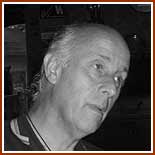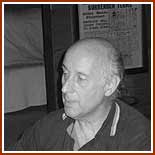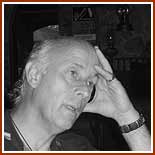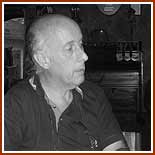 |
|
 "In 1939, they were on foot with knapsacks and beaters and today we have trucks, helicopters and far more equipment available to us."  "In 1939 we didn�t have the road infrastructure that we have today. The only way in and out of those forests were on wooden tram tracks."  "When I think of it, I�d call them heroes because they went and did the impossible with very little."  "People always say, �The main enemy is the fire�. I say there are two enemies. The other enemy is time."  "If we had not had the Linton fires and lost those lives, we wouldn�t be so stringent in our fire fighting practices." |
Allan Marks CFA Group Officer for the Dandenong Ranges Fire Brigade Group  What I learned out of the 1939 fires was that people didn�t perform fire management functions and fire prevention as we do today. They were on foot with knapsacks and beaters and today we have trucks, helicopters and far more equipment available to us. What they learned after the 1939 fires was that they needed better access to water. So they decided to make some small trestles and locate them strategically around the fire and put 44-gallon drums of water on them so they could re-fill their knapsacks with water. Today we have access to portable dams that we can bring in and set up, and now helicopters can draw water from them for fire-fighting. When you look at pictures of these men fighting fires in 1939, you saw people dressed in hats, shirts, waist-jackets, pants and knapsacks and that was how it was done. They didn�t have the uniforms that we have today, and everyone fighting fires in the CFA today has to be trained and accredited. When I lecture to brigades on incident control and disaster, people always say, �Oh, the main enemy is the fire�. I always say, �No there�s two enemies. The other enemy is time�. There were also two enemies in �39 ,�62 , �68 ,�78 , �83 , �97 and 2003, and I think people forget that.  I get a pager call and it might say �reported fire at Sassafras �. From the time we get that call to the time we get to the fire station might be two to five minutes. And in that time - being volunteers � all we have to do is get in our car and drive to the station. I get a pager call and it might say �reported fire at Sassafras �. From the time we get that call to the time we get to the fire station might be two to five minutes. And in that time - being volunteers � all we have to do is get in our car and drive to the station.Then you�ve got to wait for the crews to get together, all put our gear on, get in the truck, open the door, get through the traffic and get to the fire - that could take eight minutes. Now if a fire can go from The Basin up to Sassafras in eight minutes - as it did in �83 and it caused devastation, then you don�t have much time to work with. And in 1939 it was so remote that they couldn�t even get there, let alone get there quickly. In 1939 they put their hats on, waist jackets, their shirts and that�s how they dressed and they�d get a beater pulled from the branch of a tree, and they�d go and beat the hell out of the fire. Today, it�s different. In �97 we had 168 tankers in the Dandenongs. So there is a vast difference, and we were supported by a couple of Canadian water bombers that happened to be in South Australia at the time. What is different is that in 1939 we didn�t have the road infrastructure that we have today. The only way in and out of those forests were on wooden tram tracks or narrow dirt roads. And in 1939 they weren�t told to stay in their homes. It�s safer to be in some form of a building, a structure � so people weren�t prepared - today we have a very different social structure. Those mill communities were completely isolated and located deep within the forests.  In the towns, they mustered their fire-fighting men by the bush telegraph and the bell. The bell would sound and the troops were rallied and they went out - and if you can actually visualise it - you would see these bands of men, probably on some primitive kind of truck heading down tracks, dirt tracks with their beaters and their knapsacks, because that�s all they had. In the towns, they mustered their fire-fighting men by the bush telegraph and the bell. The bell would sound and the troops were rallied and they went out - and if you can actually visualise it - you would see these bands of men, probably on some primitive kind of truck heading down tracks, dirt tracks with their beaters and their knapsacks, because that�s all they had.I was captain of Selby fire brigade for eight years during which time we had the Ash Wednesday fires through here, through the Belgrave Heights South, and those fires went through to Officer and took out Beaconsfield, and Cockatoo was also affected. So after eight years as captain I stepped down from that role and had a break for a while. I was still involved in the CFA when I became part of the Dandenong Ranges Fire Brigade group. There are about 112 groups in Victoria who have a cluster of brigades within their boundaries. I�ve been group officer now for the Dandenong Ranges Group for 14 years, and we have 13 brigades in our group that cover an area from Narre Warren East to Upway, through to Kalorama and out to as far as Macclesfield. I suppose we are a very focal and vocal group. We�ve had a lot of fire history here and that gives us good groundings for discussion and expressing our concerns on issues that develop and it�s an ongoing issue. It�s something that you just don�t close down, even once our fire season is over, we don�t just all hibernate like bears. We are maintaining equipment and still regularly involved with fire operation. There are planning initiatives through the brigades and into council associations within the CFA, so it�s ongoing. I will also spend between 10 and 20 hours each week within my role as I also sit on the executive of the Municipal Fire Prevention Committee within the Shire of the Yarra Ranges.  My role is initially - if we have a major incident develop, and I use the term major - I take on the role as incident controller. I was incident controller in �97 for the fires in the Dandenongs
- that was the initial 12-hour shift. The first shift usually involves the main impact of the
fires. We�ve had about four fires this year, deliberately-lit fires ranging from Cardinia Reservoir round to Lysterfield and each time I�ve taken the role of an incident controller. My role is initially - if we have a major incident develop, and I use the term major - I take on the role as incident controller. I was incident controller in �97 for the fires in the Dandenongs
- that was the initial 12-hour shift. The first shift usually involves the main impact of the
fires. We�ve had about four fires this year, deliberately-lit fires ranging from Cardinia Reservoir round to Lysterfield and each time I�ve taken the role of an incident controller.I�m actually trained up to level two in incident management disaster. If we had not had the Linton fires and lost those lives, we wouldn�t be so stringent in our fire fighting practices, the authority today wouldn�t be so accountable for the training and the accreditation of all volunteers. We all have to be accredited right across the board and the training is ongoing. In the 1939 fires, those Bushmen would have been under the command of somebody who had been around the forests and bush for a long time and had fire-fighting experience but they wouldn�t have had any fire-fighting training back in �39 compared with what we do today. They would have just battled long and hard with what they had to save lives and homes. If I took you today to a fire station and you walked around and looked at the equipment, and came and saw what I carry in my car alone, you wouldn’t believe the difference. When I think of those fire-fighters in ‘39 I’d probably call them heroes, because they went and did the impossible with very little. |
The Firefighters
Len Foster
Chairman and CEO of the Australasian Fire Authorities Council Gary Morgan Chief Fire Officer for the Department of Sustainability and the Environment Russell Rees CFA Chief Officer Allan Marks CFA Group Officer for the Dandenong Ranges Fire Brigade Group Greg Head CFA Captain of the fire brigade in Warburton John Rigby Coordinating chaplain for the Country Fire Authority Mike Leonard Manager of Strategic Planning - Fire Management, at the Department of Sustainability and Environment John Masterton Burns surgeon. Head of the Burns Unit at the Alfred Hospital from 1967 - 1996. |
 |